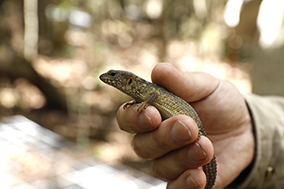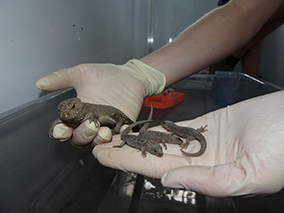Nangur spiny skink
Reducing the extinction risk for the Nangur spiny skink
With intricate patterns and spiny scales, the Nangur spiny skink looks fierce, but this native animal needs our support to survive and thrive in Queensland.

Fast facts
Common name: Nangur spiny skink, Nangur skink
Species name: Nangura spinosa
Family: Scincidae
Status: Critically endangered
Habitat: Semi-evergreen vine thicket and vine forest, often with emergent hoop pine.
Species overview
The Nangur spiny skink is found only in South East Queensland, just outside Gympie.
The Nangur spiny skink lives on the Country of the Kabi Kabi People and Wakka Wakka People. We are still gathering knowledge about the skink’s cultural significance, ecology and behaviour.
In 1992, scientists found the Nangur spiny skink in the Nangur National Park.
Early surveys of the first population estimated there were more than 140 adults. Their number rapidly declined between 2015 and 2019 (a period of low rainfall), falling to less than 50 adults occupying an area of less than 50ha.
In 1997, a second distinct population was found approximately 40km to the east in Oakview National Park.
Surveys estimate up to 1,000 adult skinks living in an area of approximately 850ha. The number of adults in the core area of this population is relatively stable, with ongoing declines at its margins, where pressure from the threats is greatest.
Extensive surveys in over 30 locations have failed to find populations other than the two in Nangur National Park and Oakview National Park. Genetic analysis shows these two populations became isolated several hundred thousand years ago.
Ecology and behaviour
The Nangur spiny skink plays an important role as predator, prey and ecosystem engineer. As predators, they help to keep insect populations in balance. As prey, they provide a valuable food source to native predators. Their burrow digging promotes ecosystem health. They also serve as valuable indicators of environmental quality, reflecting the state of their habitat, which several other threatened species share.
Nangur spiny skinks live in a single-entrance burrow, rarely moving more than one metre from the burrow. From late January to early February, the females give birth to up to 4 live young. Some juveniles stay in their mother’s burrow for up to 1 year.
The skinks are most active outside their burrow entrances during dusk and dawn when they are often feeding. They primarily feed on small insects and invertebrates like beetles, spiders, snails, cockroaches and crickets.
Characteristics
The adult Nangur spiny skink is:
- up to 20cm long, with a snout-to-vent length of up to 10cm
- between 18–38g, with newborns weighing between 1.2 and1.5g
- brown with dark irregular bands (sometimes faded) on its back
- covered with spiny scales along its back, tail and flanks (hence its species name ‘spinosa’)
- cream-coloured belly, with the scales around its mouth barred with cream and brown.
Threats
- Introduced animals, including cats, foxes, pigs, deer and cane toads
- Introduced plants, including coral berry, cat’s claw creeper and lantana
- Habitat loss or modification due to land clearing and forestry
- Climate change, especially uncontrolled fires and increasing weather extremes of flooding and drought
- Human activity, including illegal collection and burrow disturbance.
What is being done?
- We manage a highly successful captive breeding and reintroduction program. Through the program, more than 50 skinks have been born, and we have seen high survival rates for adults and juveniles.
- The program started in 2020 when we collected 14 adults and one juvenile from the larger population for a pilot program. Within weeks, the first Nangur spiny skinks were born in captivity, and within a year, skinks were conceived and born in captivity.
- In 2023, we released 20 skinks from the captive program into artificial burrows in an area west of Gympie.
Eighteen months later, there was a population of over 50 skinks, with high survival rates for the released individuals and natural breeding producing offspring. - An ongoing focus is the recovery and reintroduction of skinks to the smallest second population to improve its genetic diversity.
- The captive breeding program includes research into the skink’s ecology and behaviour, such as its longevity, age to maturity, and its possible ability to transfer water through capillary action to its mouth.
- We also conduct surveys to monitor the skink’s population size, trajectory and threatening processes.
- We implement and monitor the success of threat abatement programs, including weed and feral animal control.
- We develop and implement fire management strategies to protect the species and its habitat from the threat of bushfires.
- Queensland’s national parks and protected areas play an important role in protecting threatened species. As part of the Queensland Protected Area Strategy 2020–2030, we’re acquiring more land to expand our protected area system and help conserve critical species habitat.

Who is helping?
- James Cook University (JCU)
JCU researchers assist with genetics research and advice to inform the management of the populations.
The Association assists with the studbook management of the species in captivity.
Since 2023, we have partnered with FAME, which financially supports the captive breeding and release program.
In 2023, the council contributed funds to Natura Pacific to produce an educational video and podcast about the skink and how the local community can help improve the quality of its habitat in the Gympie region.
This group assists with land management activities, particularly weed control in areas where the skink occurs.
First Nations people from these corporations work closely with our Queensland Parks and Wildlife Service rangers to undertake land management activities on Country.
- Nature refuge owners
Landowners whose properties are adjacent to national parks help control weeds and pest animals and using mosaic burning techniques to help conserve key habitat values.
How you can help
- If you live in the Gympie region keep your cat indoors as much as possible, especially at night. Remove introduced plants such as coral berry, cat’s claw creeper, rat’s tail from your property.
- When visiting protected areas like Nangur and Oakview National Parks, make sure your shoes, car tyres and camping equipment is clean to avoid the spread of disease.
- Help protect all types of skinks by creating a skink-friendly habitat in your garden. Include rocks, logs and large branches for them to sun themselves on and shelter/hide under. Leave leaf litter and coarse wood mulches around plants to encourage nests and hiding places. Plant local native grasses and ground covers or make a skink box.
- Make a donation to support Queensland threatened species protection and science and research-based initiatives.
- Find out more about how you can help support threatened species efforts.
More information
- Back from the Brink video and podcast
- Recovery plan for the Nangur spiny skink (Australia)
- Species profile (Qld, Wildnet)
- Species profile (Australia, SPRAT)


